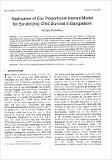| dc.description.abstract | The child survival strategies and interventions are considered to be the fourth obligation of Millennium Development Goal which focused on reducing under five child mortality in near future. Thus many countries are now devoted to the child survival interventions as a way of reducing the child mortality. This study aims to evaluate the predictors of child survival (age under 5 years) in Bangladesh by utilizing data extracted from 2011 Bangladesh Demographic and Health Survey (BOHS, 2011). For study purpose contingency analysis and Cox's proportional hazard model technique have been applied to different demographic, socio-economic and health care service related variables. Entirely division, socioeconomic status, mother's age, education, and her working status, birth order, antenatal care during pregnancy, breast feeding status, child's medical check-up and proper immunization have been found as major factors by using both cross-tabulation and Cox's proportional hazard techniques that raise child survival and decrease child mortality in Bangladesh. Finally, these findings suggest that an increase in mother's education, breast feeding to child, encourage child bearing age of mothers at 21-40 years. Improve health care services for both mother and child could in turn raise child survival and reduce the rate of under-five child mortality in Bangladesh. | en_US |

